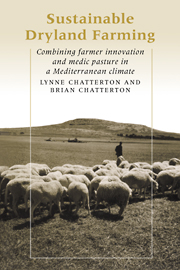 Sustainable Dryland Farming
Sustainable Dryland Farming Book contents
- Frontmatter
- Contents
- Preface
- Part one Medic and other systems
- Part two The Projects
- 4 A demonstration medic farm in Libya
- 5 The grazing phase and farmer training
- 6 A medic project in Algeria
- 7 A medic project in Jordan
- 8 Two medic projects in Iraq
- Part three Institutions, agencies, local farmers and technicians
- References
- Index
7 - A medic project in Jordan
Published online by Cambridge University Press: 22 September 2009
- Frontmatter
- Contents
- Preface
- Part one Medic and other systems
- Part two The Projects
- 4 A demonstration medic farm in Libya
- 5 The grazing phase and farmer training
- 6 A medic project in Algeria
- 7 A medic project in Jordan
- 8 Two medic projects in Iraq
- Part three Institutions, agencies, local farmers and technicians
- References
- Index
Summary
Introduction
By 1979 the Libyan projects were providing good models of the cereal phase, the grazing phase, and rangeland re-vegetation using medics. The provision of appropriate machinery and expert farming advice to farmers was achieving rapid adoption of these models.
The Algerian project had finished and had left on record further proof that shallow cultivation and regeneration of medic pastures depended on the availability of scarifiers and that medic pastures provided cheaper and more sustainable grazing and nutrition than was presently available in the region. The Algerian project also showed that without direct support to the farmers adoption of project results could not take place.
Neither project had encountered difficulties using the imported medic seed from Australia and both had found large numbers of local medics in many locations that could deal with possible problems of climatic or economic origin. Neither project had established a specific seed production program but had made a good start on the identification of local ecotypes and this together with shallow cultivation and precision seeding made up the package necessary for a successful seed industry.
The achievements of these projects created much interest in the region and the Jordanian Ministry, already negotiating with the Australian Government aid agency (AIDAB) for an agricultural project, was keen to try a medic system on their farms.
The Jordan project began in 1979 and continued until 1991 when the war in Iraq caused the evacuation of the team.
- Type
- Chapter
- Information
- Sustainable Dryland FarmingCombining Farmer Innovation and Medic Pasture in a Mediterranean Climate, pp. 166 - 193Publisher: Cambridge University PressPrint publication year: 1996
